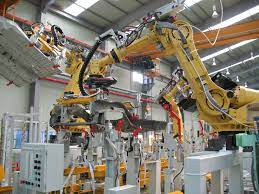How Modern Manufacturing and Engineering have Improved
Manufacturing materials, processes, and systems have existed for thousands of years. In this article, we would talk about modern manufacturing processes.
Our discussion will focus on modern manufacturing and engineering areas such as; (1) microelectronics, (2) computerization of producing, (3) flexible manufacturing, (4) microfabrication and nanotechnology, (5) lean production, and 6 Sigma.
Microelectronics in Modern Manufacturing

Microelectronics involves electronic devices that are fabricated on a microscopic scale. Examples include integrated circuits, which comprise components like transistors, diodes, and resistors that are fabricated and electrically connected on a little flat chip, usually a product of silicon.
The remarkable feature about today’s microelectronics devices is that the huge number of components that can be contained onto the chip.
The aptitude to fabricate integrated circuits dates from the first 1960s and has advanced to the purpose where this technology is termed giga-scale integration, meaning that chips are being produced comprising billions of components. Microelectronics has become so pervasive that an outsized proportion of the common items used today are supported this technology.
Computerization of producing in Modern Manufacturing

The computerization of producing the primary digital computers goes back to the mid-1940s, but their applications in manufacturing came quite a few years later. Within the mid-1960s direct numerical control was developed, within which mainframe computers were employed to remotely control machine tools in factories.
As technology developed, enabled by advances in microelectronics, the price of computers and processing was reduced, resulting in the widespread use of private computers, not only within the office but also within the factory for tasks starting from the control of individual equipment in the shop floor to manage of the data required to manage the complete enterprise.
The net has allowed modern manufacturing companies to communicate among their own geographically distributed plants and offices, and it’s also provided access to customers and suppliers around the world.
Flexible Manufacturing

For the most part of the 20th century, the stress in the manufacturing industries within the U. S. was on production to satisfy the buyer demands of a rapidly growing population. Production remains widely employed in the US and throughout the planet, but computerization has enabled modern manufacturing companies to develop systems that can address product variations.
Cellular manufacturing and mixed-model assembly lines are two samples of operated by hand manufacturing systems that can manufacture a range of parts or products without the time-consuming downtime for changeover.
The auto industry, in particular, is designing its final assembly lines in order that ever-greater model variations can be accommodated on one line to fulfill changing and unpredictable demand patterns. Computerization has also allowed flexibility to be designed into automates systems, samples of which are the flexible manufacturing systems.
Closely associated with flexible modern manufacturing is mass customization, which involves a production system that’s capable of manufacturing individualized products for every customer. The customer specifies the model and options, and also the product is created to those specifications.
Microfabrication and Nanotechnology

Another recent modern manufacturing development that is closely associated with microelectronics, is that the introduction of materials and products whose dimensions are sometimes so small that they can’t be seen by the oculus. In extreme cases, these things cannot even be seen under an optical microscope. Products that are so miniaturized require special fabrication technologies.
Microfabrication Meaning
Microfabrication refers to the processes needed to create parts and products whose features sizes are within the micrometer range. Examples include ink-jet printing heads, compact discs (CDs and DVDs), and microsensors used in automotive applications (e.g., air-bag deployment sensors).
What Nanotechnology Is
Nanotechnology refers to materials and products whose feature sizes are within the nanometer scale, a scale that approaches the scale of atoms and molecules. Ultra-thin coatings for catalytic converters, flat-screen TV monitors, and cancer drugs are samples of products supported by nanotechnology. The technological and economic importance of microscopic, nanoscopic materials and products are expected to extend within the future, and processes are needed to supply them commercially.
Lean Production and 6 Sigma

These are two programs aimed at improving efficiency and quality in modern manufacturing by applying technology to business. They address demands by customers for products they buy to be both low in cost and high in quality.
Lean production and Six Sigma are being widely adopted by companies, especially within the U. S.Lean production is predicated on the Toyota Production System developed by Toyota Motors in Japan.
Its origins start in the 1950s and 1960s when Toyota began using unconventional approaches to boost quality, reduce inventories, and increase flexibility in its operations. Lean production may be defined simply as “doing more work with fewer resources.”
It implies that we need fewer workers and fewer types of equipment to accomplish more production in less time and yet achieves higher quality within the final product. The underlying aim of lean production is that the elimination of varied kinds of waste, like producing defective parts, excessive inventories, and workers waiting.
Six Sigma was started in the 1980s at Motorola Corporation within the US. The objective was to scale back variability within the company’s processes and products to increase customer satisfaction.
Today, Six Sigma may be defined as “a quality-focused program that uses worker teams to accomplish projects aimed toward improving an organization’s operational performance.”
You can also read about mobile applications development and how it affects businesses.




